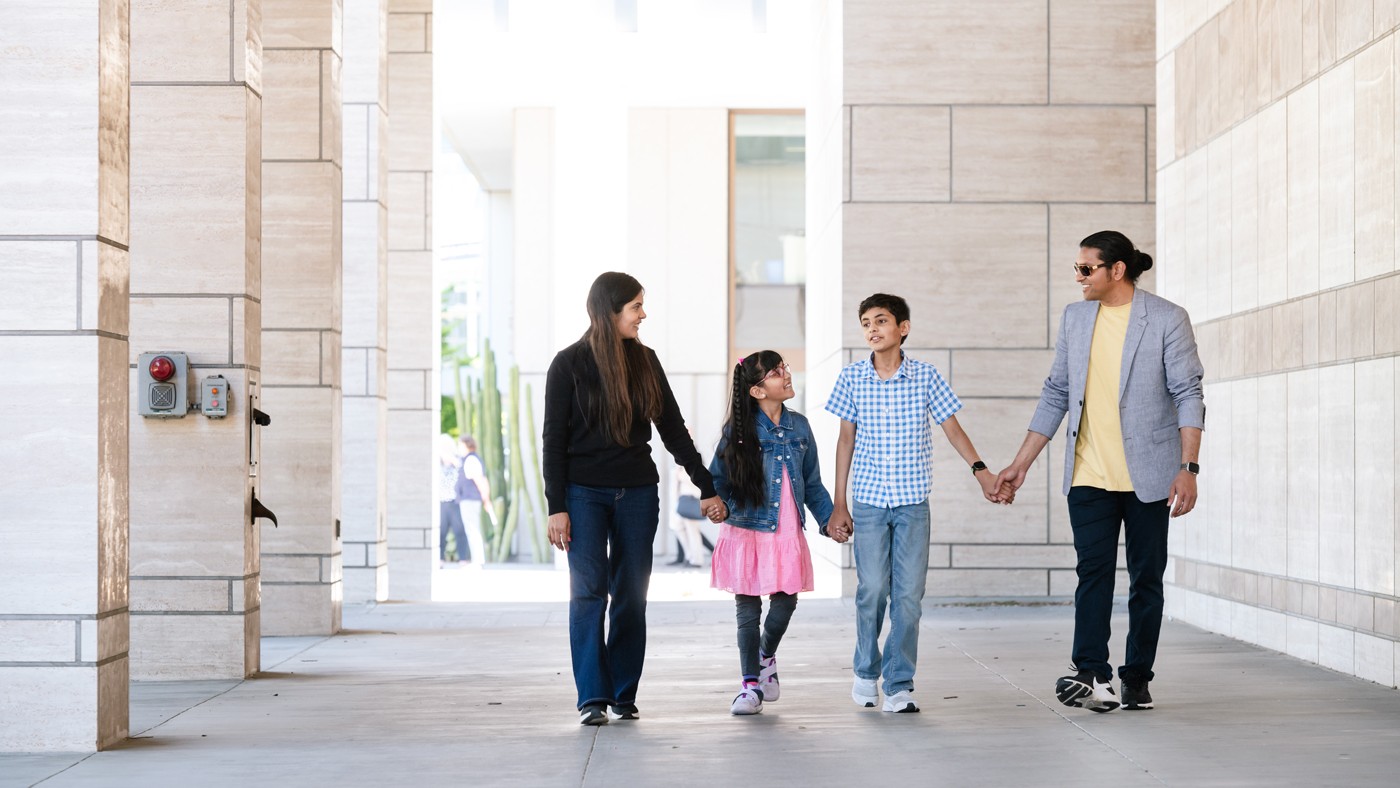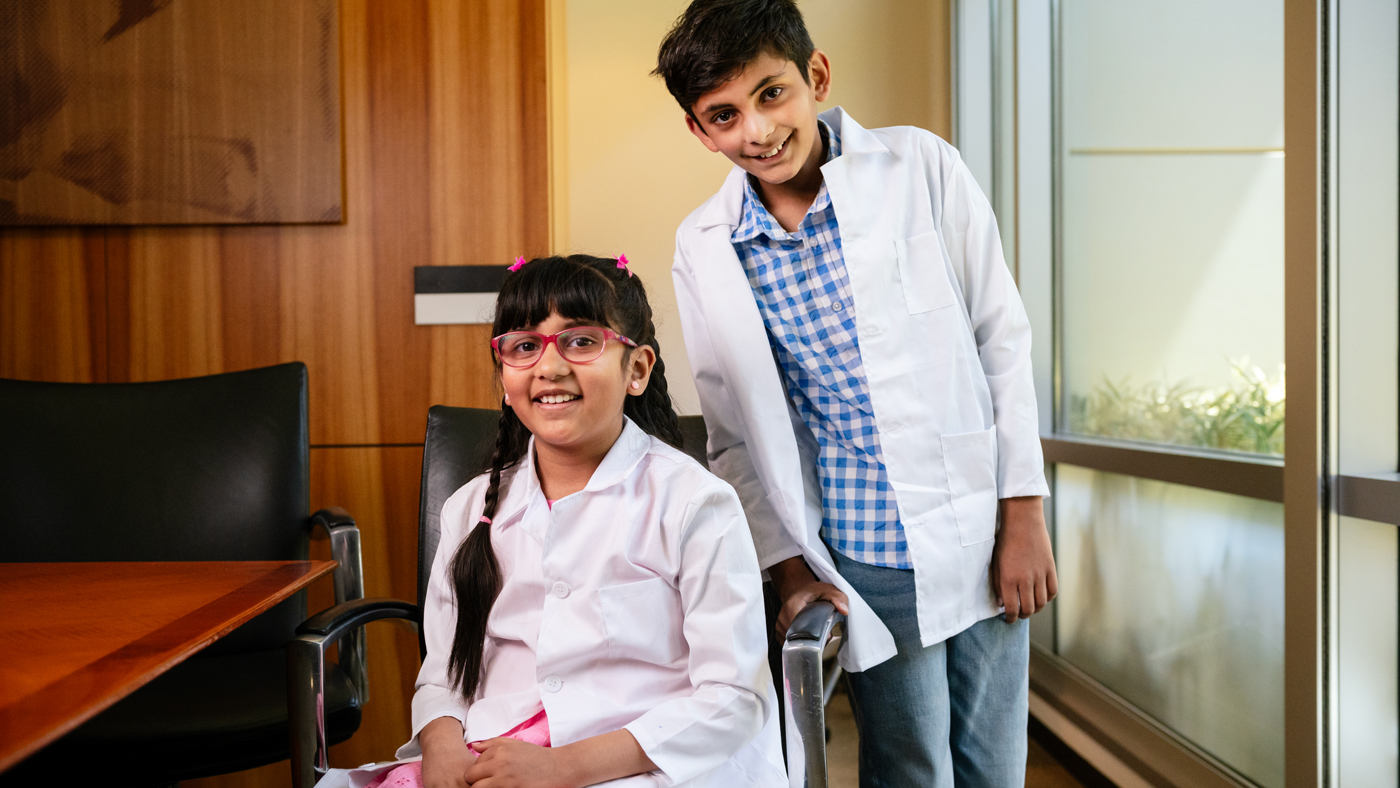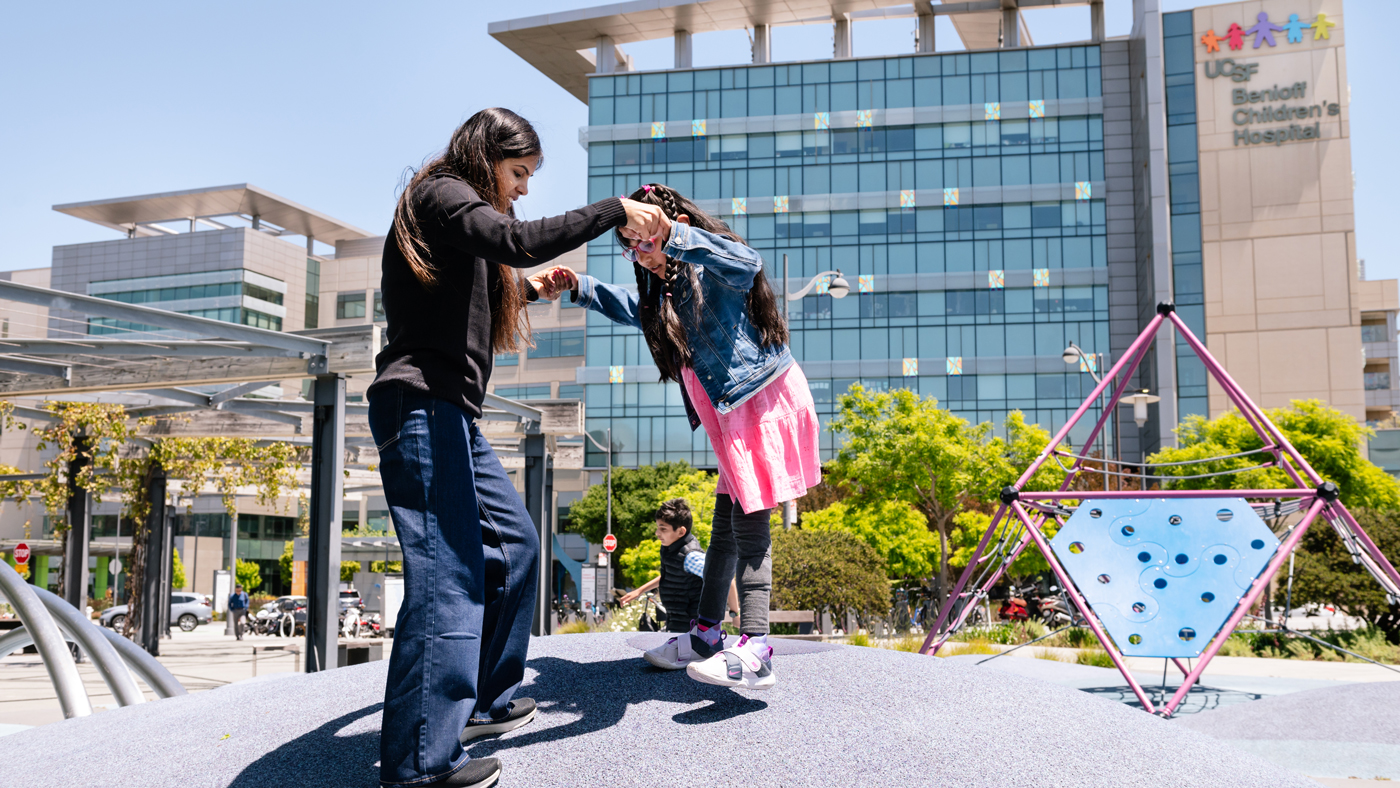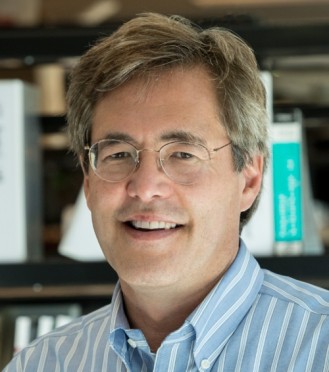Gladstone NOW: The Campaign Join Us on the Journey✕

Saisha Adokar (second from left), an 8-year-old with Charcot-Marie-Tooth disease, recently visited Gladstone with her parents Priyanka Lekurwale (left) and Rahul Adokar (right), and her brother Kinshuk Adokar (second from right).
Saisha Adokar is a charismatic 8-year-old girl with thick dark braids who loves chess, singing, skiing in her home state of Utah, and playing with her older brother Kinshuk. She is also affected by Charcot-Marie-Tooth disease (CMT), a genetic neuropathy that causes progressive damage to nerves in her legs and arms, slowly reducing her ability to walk and use her hands.
Over two sunny days in spring 2023, Saisha, Kinshuk, and their parents Priyanka Lekurwale and Rahul Adokar visited Gladstone Institutes to meet with Senior Investigator Bruce Conklin, MD, who had generated induced pluripotent stem (iPS) cells from a blood sample Saisha had provided on a prior visit. iPS cells resemble embryonic stem cells in that they can be transformed into new cell types in a dish. Conklin’s lab is using these cells to develop a precision medicine approach that could potentially help Saisha.
Many Causes, but No Cures
CMT is one of many genetic neuropathies—nerve disorders that are caused by mutations in one or more genes. Saisha’s CMT is caused by a mutation in a gene known as MFN2. Although this gene is commonly linked to CMT, Saisha’s particular MFN2 mutation is only shared by a handful of patients worldwide. Studying her mutation could therefore provide valuable scientific insights.
The damage CMT has caused to Saisha’s peripheral nerves first appeared in her feet and later progressed to her hands when she was around 2 years old. Right now, she can hold a marker to write her name and draw, but she has difficulty removing the caps from markers, so Kinshuk is sure not to fully close them whenever the two are drawing together.

Saisha (left) and Kinshuk (right) were given a tour of Bruce Conklin’s lab, which is developing a gene editing therapy to treat Saisha’s CMT2A.
Similarly, she has lost the fine motor skills in her fingers to precisely hold and place toys when she plays. When she and Kinshuk build structures out of magnetic tiles, for example, Saisha pins the largest pieces between her palms and sometimes asks her brother to assist her in connecting them to smaller pieces.
The family celebrates Saisha’s abilities—she is a strong chess player who regularly beats adults, and she can ski slopes with her father that are too terrifying for Kinshuk—and doesn’t openly dwell on her limitations. They know that the disease may progress to nerves in other parts of her body but they are also hopeful that Conklin’s research may help stem the deterioration.
Personalized—And Personal—Medicine
Saisha’s parents first learned about Conklin’s research after reading a research paper he co-authored in 2021 with Luke Judge, MD, PhD, associate professor of pediatrics at UC San Francisco (UCSF) Benioff Children’s Hospital. In that paper, the scientists used genome editing to silence the mutant copy of the gene that causes CMT2E, a form of CMT that is different from Saisha’s, in cultured spinal motor neurons generated from patient-derived iPS cells.
Every person has two copies (or “alleles” in genetics lingo) of every gene in their cells, each inherited from one parent. In patients with CMT2E, only one copy of the gene linked to the disorder is mutated, while the other copy remains healthy.
Conklin and Judge took advantage of this underlying biology in their experiments. They predicted that if they inactivated only the mutant copy, the remaining, healthy copy of the gene would be sufficient to support typical function in the motor neuron cells. As predicted, inactivating only the mutant copy, while leaving the healthy copy intact, reversed the disease phenotype in the lab.
Priyanka and Rahul emailed the two scientists to inquire whether this approach could be applied to Saisha’s version of CMT, CMT2A, and were surprised to get a response.
“We sent hundreds of emails to researchers, but we didn’t hear from many,” says Rahul Adokar. “So, it was nice to see a response back. This research has been a ray of hope for the last two years for me and my family.”

Priyanka (left) is hopeful that gene editing research from Gladstone and UCSF will help treat her daughter Saisha’s (right) progressive CMT2A disease.
That initial outreach led to the family’s first visit to Gladstone in 2022. During that trip, Saisha was also seen by Alex Fay, MD, PhD, who sees children with a range of neuromuscular disorders, including CMT, and collaborates with Conklin and Judge.
Since that first visit, Conklin’s lab has sequenced Saisha’s DNA in order to refine their gene editing approach. It turns out that her cells are one of the more robust iPS cell lines for studying CMT2A in the lab, so they are increasingly used to look for therapeutic opportunities—not just for Saisha, but for many others affected by CMT2A.
“At the moment, we can use medications to treat pain that may come up in some people with CMT, but we currently don’t have a way to fix the genetic problem that’s affecting their nerves,” says Fay, a pediatric neurologist at UCSF Benioff Children’s Hospital and head of the CMTA Center of Excellence.
“The field of CMT is really ripe for clinical and scientific discovery,” he continues. “Hopefully, soon, we’ll actually be able to see a completely different future for CMT than we have right now.”
A New Therapeutic Window
The gene editing revolution, launched in part by Gladstone Senior Investigator Jennifer Doudna, PhD’s Nobel Prize-winning research on CRISPR-Cas9, provides a suite of molecular tools to potentially fix the genetic defects that underlie diseases like Saisha’s.
“You think about patients and their families who’ve been told that their disease is completely untreatable, and then CRISPR comes along—now we’re in a situation where many genetic neuropathies are not only potentially treatable, but for CMT, it’s actually one of the most approachable scientifically,” says Conklin. “There are definitely hurdles that we need to understand, but all of those hurdles, at least in our eyes, will be easily surmountable. That’s a tremendous opportunity.”
“You think about patients and their families who’ve been told that their disease is completely untreatable, and then CRISPR comes along—now we’re in a situation where many genetic neuropathies are not only potentially treatable, but for CMT, it’s actually one of the most approachable scientifically.”
Right now, Conklin and his team are developing new CRISPR tools to inactivate, or silence, Saisha’s broken copy of MFN2, while leaving the healthy copy intact. They expect that Saisha’s healthy copy of MFN2 will compensate once the broken copy is inactivated, similar to what was observed in Conklin and Judge’s CMT2E study. Although the work is several years from a clinical trial, it is providing hope to the Adokar family and others affected by similar disorders.
“We don’t know how this research is going to turn out, but it provides so much hope for the future for families like us,” says Priyanka Lekurwale. “When you get a diagnosis and there is literally nothing to stop or slow down the progression in your child’s disease, it is very hard to accept. We are grateful to the teams at Gladstone and UCSF for their research.”
Community Funding Supports an Unmet Clinical Need
The strides that Conklin and his team have made toward a therapy for CMT2A and other genetic neuropathies are due in part to generous support from the Charcot-Marie-Tooth Association (CMTA).
“The genetic causes of CMT are well known,” says Gilles Bouchard, chairman of the board at the CMTA, whose son Yohan was diagnosed with CMT over two decades ago. “We know what we have to fix. So, when CRISPR came along, we felt excited about it because the whole goal of CRISPR is to fix issues at a genetic level, which is really the root cause of Charcot-Marie-Tooth.”
It is Conklin’s hope that by focusing on genetic neuropathy disorders such as CMT in the near term, he can establish a therapeutic proof of principle that his lab can apply more broadly down the road. For example, degenerative diseases involving vision, hearing, memory and cardiac function could also benefit from this approach.
“The patients and their families provide tremendous energy to our research,” he says. “My lab is filled with people who want to contribute to helping people with disease.”
Thanks to technological advances pioneered by Gladstone scientists—such as gene editing and stem cell biology—along with the innovative research being done in Conklin’s lab, the clinical expertise of Judge, Fay, and others at UCSF, and the support of funders like CMTA, a treatment for people like Saisha and others with genetic neuropathies may soon be a reality.
Featured Experts
Support Discovery Science
Your gift to Gladstone will allow our researchers to pursue high-quality science, focus on disease, and train the next generation of scientific thought leaders.
Gladstone’s Scientific Highlights of 2025
Gladstone’s Scientific Highlights of 2025
From fundamental insights to translational advances, here’s how Gladstone researchers moved science forward in 2025.
Gladstone Experts Alzheimer’s Disease Autoimmune Diseases COVID-19 Neurological Disease Genomic Immunology Cardiovascular Disease Data Science and Biotechnology Infectious Disease Conklin LabScience in Seconds | Researchers Pinpoint Key Gene Behind Heart Defects in Down Syndrome
Science in Seconds | Researchers Pinpoint Key Gene Behind Heart Defects in Down Syndrome
In this video, Gladstone scientists share how they used stem cells, gene editing, and AI to identify a gene driving heart defects in Down syndrome—and how reducing its levels in mice restored normal heart development, offering hope for future treatments
Gladstone Experts Cardiovascular Disease Data Science and Biotechnology Pollard Lab Srivastava Lab AI Big Data CRISPR/Gene Editing Human Genetics Stem Cells/iPSCsScience in Seconds | The Thinking Microscope: Research Powered by an AI Brain
Science in Seconds | The Thinking Microscope: Research Powered by an AI Brain
In this video, Steve Finkbeiner and Jeremy Linsley showcase Gladstone’s groundbreaking “thinking microscope”—an AI-powered system that can design, conduct, and analyze experiments autonomously to uncover new insights into diseases like Alzheimer’s, Parkinson’s, and ALS.
Gladstone Experts ALS Alzheimer’s Disease Parkinson’s Disease Neurological Disease Finkbeiner Lab AI Big Data




